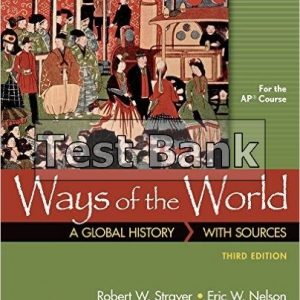This is completed downloadable of Test Bank for The Humanities: Culture, Continuity, and Change, Volume 2 4th Edition Sayre

Product Details:
- ISBN-10 : 0134789431
- ISBN-13 : 978-0134789439
- Author:
For courses in Introduction to the Humanities See context and make connections across the humanities The Humanities: Culture, Continuity, and Change leads students on a journey through countless “ah-ha” moments as they piece together the cultural history of the world. Believing that students learn best by remembering stories rather than memorizing facts, author Henry Sayre deftly conveys multifaceted cultural experiences via a storytelling approach that students will remember – during the course and beyond. Updated with numerous new images and examples, the 4th Edition analyzes recent works such as Lin-Manuel Miranda’s Hamilton: An American Musical to help students see how course concepts can help them understand resonant contemporary works.
Table of Content:
- Part Four Excess, Inquiry, and Restraint 1600–1800
- 21 The Baroque in Italy The Church and Its Appeal
- Learning Objectives
- Baroque Style and the Counter-Reformation
- Sculpture and Architecture: Bernini and His Followers
- The Society of Jesus
- San Carlo alle Quattro Fontane
- The Drama of Painting: Caravaggio and the Caravaggisti
- Master of Light and Dark: Caravaggio
- The Baroque and Sexuality: Caravaggio and the Metaphysical Poetry of John Donne
- Elisabetta Sirani and Artemisia Gentileschi: Caravaggisti Women
- Venice and Baroque Music
- Giovanni Gabrieli and the Drama of Harmony
- Claudio Monteverdi and the Birth of Opera
- Arcangelo Corelli and the Sonata
- Antonio Vivaldi and the Concerto
- Chapter Review
- Reading
- 22 The Secular Baroque in the North The Art of Observation
- Learning Objectives
- Calvinist Amsterdam: City of Contradictions
- Gaining Independence from Spain
- The Dutch East India Company in Batavia
- Tulipomania
- The Dutch Reformed Church: Strict Doctrine and Whitewashed Spaces
- The Science of Observation
- Francis Bacon and the Empirical Method
- René Descartes and the Deductive Method
- Johannes Kepler, Galileo Galilei, and the Telescope
- Antoni van Leeuwenhoek, Robert Hooke, and the Microscope
- Dutch Vernacular Painting: Art of the Familiar
- Still Life
- Landscapes
- Genre Scenes
- Johannes Vermeer and the Domestic Scene
- The Group Portrait
- Rembrandt van Rijn and the Drama of Light
- The Drama of Light
- Rembrandt and the Self-Portrait
- The Baroque Keyboard
- Jan Pieterszoon Sweelinck’s Fantasias for the Organ
- The North German School: Johann Sebastian Bach
- Vocal Music
- Instrumental Music
- Chapter Review
- Reading
- 23 The Baroque Court Absolute Power and Royal Patronage
- Learning Objectives
- Absolutism and the Arts: Louis XIV and the French Court
- The Tastes of Louis XIV
- The Painting of Peter Paul Rubens: Color and Sensuality
- The Painting of Nicolas Poussin: Classical Decorum
- Music and Dance at the Court of Louis XIV
- Dance Forms
- Theater at the French Court
- The Art and Politics of the English Court
- Anthony van Dyck: Court Painter
- Puritan and Cavalier Literature
- Henry Purcell and English Opera
- The Arts of the Spanish Court
- Diego Velázquez and the Royal Portrait
- The Literature of the Spanish Court
- The Plays of Lope de Vega and Calderón
- The Satires of Francisco de Quevedo
- The Baroque in the Americas
- Lima and Cuzco
- Baroque Music in the Americas: Sor Juana Inés de la Cruz
- The Churrigueresque Style: Retablos and Portals in New Spain
- Chapter Review
- Reading
- 24 The Rise of the Enlightenment in England The Claims of Reason
- Learning Objectives
- The New London: Absolutism Versus Liberalism
- Absolutism versus Liberalism: Thomas Hobbes and John Locke
- John Milton’s Paradise Lost
- The English Enlightenment
- Satire: Enlightenment Wit
- Hogarth and the Popular Print
- The Satires of Jonathan Swift
- The Classical Wit of Alexander Pope
- The English Garden
- Isaac Newton: The Laws of Physics
- The Industrial Revolution
- Handel and the English Oratorio
- Literacy and the New Print Culture
- The Tatler and The Spectator
- The Rise of the English Novel
- Daniel Defoe’s Fictional Autobiographies
- The Epistolary Novel: Samuel Richardson’s Pamela
- The Comic Novels of Henry Fielding
- The World of Provincial Gentry: Jane Austen’s Pride and Prejudice
- Samuel Johnson: Stylist and Moralist
- Exploration in the Enlightenment
- Cook’s Encounters in the South Pacific
- Polynesia and the Maori
- Easter Island
- Melanesia
- Australia
- Hawaii
- Cook in the North Pacific
- Chapter Review
- Reading
- 25 The Rococo and the Enlightenment on the Continent Privilege and Reason
- Learning Objectives
- The Rococo
- Rococo Painting in France: The Fête Galante and the Art of Love
- Rococo Architecture and Landscape Design in Central Europe and England
- Balthasar Neumann and Giovanni Tiepolo in Bavaria
- Prussia and the Rococo
- The Philosophes
- Denis Diderot and the Encyclopédie
- Jean-Jacques Rousseau and the Cost of the Social Contract
- Voltaire and French Satire
- Art Criticism and Theory
- Gotthold Ephraim Lessing’s Laocoön
- Rococo and Classical Music
- The Symphonic Orchestra
- Symphonic Form
- The String Quartets of Joseph Haydn
- Wolfgang Amadeus Mozart: Classical Complexity
- The Popularization of Opera
- Opera Seria versus Opera Buffa
- Mozart’s Stylistic Synthesis
- China and Europe: Cross-Cultural Contact
- Chinoiserie
- The Arts in the Qing Dynasty (1644–1911)
- Chapter Review
- Readings
- 26 The Rights of Man Revolution & the Neoclassical Style
- Learning Objectives
- The American and French Revolutions
- The Road to Revolt in America: War and Taxation
- The Declaration of Independence
- The Declaration of the Rights of Man and Citizen
- The Reign of Terror
- The Rights of Woman
- Olympe de Gouges: The Call for Universal Rights
- Mary Wollstonecraft: An Englishwoman’s Response to the French Revolution
- The Neoclassical Spirit
- Neoclassicism and the American Political System
- Neoclassical Values in Britain and America
- The British Influence: Robert Adam and Josiah Wedgwood
- American Neoclassical Architecture
- Neoclassical Sculpture in America
- Jacques-Louis David and the Neoclassical Style in France
- Angelica Kauffmann
- Napoleon and Neoclassical Paris
- The Consulate and the Napoleonic Empire: 1799–1815
- Art as Propaganda: Painting, Architecture, Sculpture
- David as Chronicler of Napoleon’s Career
- Ingres’s Glorification of the Emperor
- Vignon’s La Madeleine
- Canova and the Bonapartes
- The Issue of Slavery
- Autobiographical and Fictional Accounts of Slavery
- The Argument for Slavery
- The Abolitionist Movement in Britain and America
- The African Diaspora
- Chapter Review
- Readings
- Part Five Romanticism, Realism, and Empire 1800–1900
- 27 The Romantic World View The Self in Nature and the Nature of Self
- Learning Objectives
- The Romantic Imagination
- The Idea of the Romantic: William Wordsworth’s “Tintern Abbey”
- A Romantic Experiment: Lyrical Ballads
- Romanticism as a Voyage of Discovery: Samuel Taylor Coleridge
- Classical versus Romantic: The Odes of John Keats
- The Romantic Landscape
- John Constable: Painter of the English Countryside
- Joseph Mallord William Turner: Colorist of the Imagination
- The Romantic in Germany: Friedrich and Kant
- Romanticism’s Darker Realities
- The Romantic Hero
- The Hegelian Dialectic and the “Great Man” Theory of History
- The Promethean Idea in England: Lord Byron and the Shelleys
- The Romantic Hero in Germany: Johann Wolfgang von Goethe’s Werther and Faust
- Goya’s Tragic Vision
- Goya before Napoleon: Social Satire
- The Third of May, 1808 : Napoleon’s Spanish Legacy
- The Black Paintings
- Beethoven and the Rise of Romantic Music
- Early Years in Vienna: From Classicism to Romanticism
- The Heroic Decade: 1802–12
- The Eroica
- The Fifth Symphony
- The Late Period: The Romantic in Music
- Romantic Music after Beethoven
- Hector Berlioz and Program Music
- Felix Mendelssohn and the “Meaning” of Music
- Song: Franz Schubert and the Schumanns
- Piano Music: Frédéric Chopin
- Chapter Review
- Readings
- 28 Industry and the Working Class A New Realism
- Learning Objectives
- The Industrial City: Conditions in London
- Water and Housing
- Labor and Family Life
- Reformists Respond: Utopian Socialism, Medievalism, and Christian Reform
- Utopian Socialism
- A.W.N. Pugin, Architecture, and the Medieval Model
- Literary Realism
- Charles Dickens’s Hard Times
- French Literary Realism
- French Painting: The Dialogue between Idealism and Realism
- Théodore Géricault: Rejecting Classicism
- The Aesthetic Expression of Politics: Delacroix versus Ingres
- Liberty Leading the People
- Caricature and Illustration: Honoré Daumier
- Realist Painting: The Worker as Subject
- Gustave Courbet: Against Idealism
- Photography: Realism’s Pencil of Light
- Chapter Review
- Reading
- 29 Defining a Nation American National Identity and the Challenge of Civil War
- Learning Objectives
- American Landscape: The Cultivated and the Sublime
- Washington Irving’s Satiric Vision
- The Hudson River Painters
- Transcendentalism and the American Romantics
- The Philosophy of Romantic Idealism: Emerson and Thoreau
- Herman Melville and the Uncertain World of Moby-Dick
- The Abolitionist Movement
- Frederick Douglass
- Other Slave Narratives
- Harriet Beecher Stowe and Uncle Tom’s Cabin
- Agassiz versus Darwin
- Romanticizing Slavery in Antebellum American Art and Music
- Eastman Johnson: The Ambiguity of Negro Life in the South
- Stephen Foster and the Minstrel Song
- The Civil War
- Representing the War
- Winslow Homer’s Magazine Illustrations
- Mathew Brady’s Photographers
- Reconstruction
- Mark Twain’s Adventures of Huckleberry Finn
- Chapter Review
- Readings
- 30 Global Confrontation and Modern Life The Quest for Cultural Identity
- Learning Objectives
- The Revolutions of 1848
- Marxism
- The Streets of Paris
- The June Days in Paris: Worker Defeat and the Rise of Louis-Napoleon
- The Haussmannization of Paris
- Revolution across Europe: The Rise of Nationalism
- Paris in the 1850s and 1860s
- George Sand: Politics and the Female Voice
- Charles Baudelaire and the Poetry of Modern Life
- Édouard Manet: The Painter of Modern Life
- Émile Zola and the Naturalist Novel
- Nationalism and the Politics of Opera
- Giuseppe Verdi and the Grand Opera
- Wagner’s Music Drama Meets the Jockey Club
- Wagner’s Music Drama
- Operetta: Jacques Offenbach and Musical Satire
- Empire and the Colonial Aspirations of the West
- The British in China and India
- China and the Opium War
- Indentured Labor and Mass Migration
- The Brief Rise and Quick Fall of Egypt
- The Opening of Japan
- Industrialization: The Shifting Political Climate
- Japanese Printmaking
- Chapter Review
- Reading
- 31 The Promise of Renewal Hope and Possibility in Late Nineteenth-Century Europe
- Learning Objectives
- French Impressionism
- Monet’s Escape to Giverny
- Morisot and Pissarro: The Effects of Paint
- Painting Leisure: Renoir and Degas
- Painting Work: Degas and Caillebotte
- Manet’s Response to Impressionism
- Russian Realism and the Quest for the Russian Soul
- The Writer and Artist under the Tsars
- The Psychological Realism of Dostoyevsky
- The Historical Realism of Tolstoy
- The Travelers: Realist Painters of Social Issues
- Russian Nationalist Music and Ballet
- Britain and the Design of Social Reform
- Morris, the Guild Movement, and the Pre-Raphaelites
- John Stuart Mill: Women’s Rights and the Question of Liberty
- Chapter Review
- Reading
- 32 The Course of Empire Expansion and Conflict in America
- Learning Objectives
- The Native American in Myth and Reality
- The Indian Removal Act
- Recording Native Americans: Catlin’s Ethnographic Enterprise
- Huron Moccasins: The Influence of European Styles on Native American Art
- Plains Narrative Painting: Picturing Personal History and Change
- Women’s Arts on the Plains: Quillwork and Beadwork
- Weaving and Basketry
- The End of an Era
- Walt Whitman’s America
- Leaves of Grass
- In the Interest of Liberty: An Era of Contradictions
- The Statue of Liberty and Tammany Hall
- Economic Depression, Strikes, and the Haymarket Riot
- The American Woman
- Representing the Tension between Genders
- Emily Dickinson: The Poetry of Enigma
- Kate Chopin and the New Feminist Novel
- Ragtime and the Beginnings of Jazz
- The American Abroad
- Henry James and the International Novel
- Painters Abroad: The Expatriate Vision
- Chicago and the Columbian Exposition of 1893
- Louis Sullivan and the Chicago School of Architecture
- Frederick Law Olmsted and the Invention of Suburbia
- Chapter Review
- Readings
- 33 The Fin de Siècle Toward the Modern
- Learning Objectives
- The Fin De Siècle: From Naturalism to Symbolism
- Art Nouveau
- Exposing Society’s Secrets: The Plays of Henrik Ibsen
- The Symbolist Imagination in the Arts
- The Sculpture of Rodin
- Rodin, Lautrec, and the World of Montmartre
- Mallarmé’s Poetry
- The Music of Debussy
- Post-Impressionist Painting
- Pointillism: Seurat and the Harmonies of Color
- Symbolic Color: Van Gogh
- The Structure of Color: Cézanne
- Closer Look: Cézanne’s Still Life with Plaster Cast
- Escape to Far Tahiti: Gauguin
- The Late Monet
- Toward the Modern
- The New Moral World of Nietzsche
- On the Cusp of Modern Music: Mahler and Brahms
- The Painting of Isolation: Munch
- Africa and Empire
- European Imperialism
- Social Darwinism: The Theoretical Justification for Imperialism
- Joseph Conrad’s Heart of Darkness
- Chapter Review
- Readings
- Part Six Modernism and the Globalization of Cultures 1900 To the Present
- 34 The Era of Invention Paris and the Modern World
- Learning Objectives
- Pablo Picasso’s Paris: At the Heart of the Modern
- The Aggressive New Modern Art: Les Demoiselles d’Avignon
- Matisse and the Fauves: A New Color
- The Invention of Cubism: Braque’s Partnership with Picasso
- Abstraction and Collage
- Futurism: The Cult of Speed
- Modernist Music and Dance: Stravinsky and the Ballets Russes
- The Expressionist Movement: Modernism in Germany and Austria
- Die Brücke: The Art of Deliberate Crudeness
- Der Blaue Reiter: The Spirituality of Color
- A Diversity of Sound: Schoenberg’s New Atonal Music versus Puccini’s Lyricism
- Early Twentieth-Century Literature
- Guillaume Apollinaire and Cubist Poetics
- Ezra Pound and the Imagists
- The Origins of Cinema
- The Lumière Brothers’ Celluloid Film Movie Projector
- The Nickelodeon: Movies for the Masses
- D.W. Griffith and Cinematic Space
- Chapter Review
- Reading
- 35 The Great War and Its Impact A Lost Generation and a New Imagination
- Learning Objectives
- Trench Warfare and the Literary Imagination
- Wilfred Owen: “The Pity of War”
- In the Trenches: Remarque’s All Quiet on the Western Front
- William Butler Yeats and the Specter of Collapse
- T.S. Eliot: The Landscape of Desolation
- Escape From Despair: Dada in the Capitals
- Russia: Art and Revolution
- Vladimir Lenin and the Soviet State
- The Arts of the Revolution
- From Suprematism to Constructivism
- The New Russian Cinema
- Freud, Jung, and the Art of the Unconscious
- Freud’s Civilization and Its Discontents
- The Jungian Archetype
- The Dreamwork of Surrealism
- Picasso and Miró
- Salvador Dalí’s Lugubrious Game
- Surrealist Sculpture
- Experimentation and the Literary Life: The stream-of-consciousness Novel
- Joyce, Ulysses, and Sylvia Beach
- Virginia Woolf: In the Mind of Mrs. Dalloway
- Marcel Proust and the Novel of Memory
- Chapter Review
- Readings
- 36 New York, Skyscraper Culture, and the Jazz Age Making It New
- Learning Objectives
- The Harlem Renaissance
- “The New Negro”
- Langston Hughes and the Poetry of Jazz
- Zora Neale Hurston and the Voices of Folklore
- The Quilts of Gee’s Bend
- All That Jazz
- The Blues and Their “Empress,” Bessie Smith
- Dixieland and Louis Armstrong in Chicago
- Swing: Duke Ellington at the Cotton Club
- The Visual Arts in Harlem
- Skyscraper and Machine: Architecture in New York
- The Machine Aesthetic
- The International Style
- Making it New: The Art of Place
- The New American Novel and Its Tragic Sense of Place
- Fitzgerald and The Great Gatsby
- Hemingway’s Michigan
- William Faulkner and the Southern Novel
- The New American Poetry and the Machine Aesthetic
- William Carlos Williams and the Poetry of the Everyday
- E.E. Cummings and the Pleasures of Typography
- Hart Crane and The Bridge
- The New American Painting: “That, Madam … is paint.”
- Charles Demuth, Charles Sheeler, and the Industrial Scene
- Marsden Hartley and the Influence of Cézanne
- Georgia O’Keeffe and the Question of Gender
- The American Stage: Eugene O’Neill
- The Golden Age of Silent Film
- The Americanization of a Medium
- The Studios and the Star System
- Audience and Expectation: Hollywood’s Genres
- Cinema in Europe
- German Expressionism
- Surrealist Film
- Chapter Review
- Readings
- 37 The Age of Anxiety Fascism and Depression, Holocaust and Bomb
- Learning Objectives
- The Glitter and Angst of Berlin
- Kafka’s Nightmare Worlds
- Brecht and the Berlin Stage
- Kollwitz and the Expressionist Print
- The Rise of Fascism
- Hitler in Germany
- Anti-Semitism
- The Bauhaus and De Stijl
- L’Esprit Nouveau and the Rise of the International Style
- The Degenerate Art Exhibition
- The Art of Propaganda
- Stalin in Russia
- The Collectivization of Agriculture
- The Rise of Social Realism in Art and Music
- Mussolini in Italy
- Franco in Spain
- Revolution in Mexico
- The Mexican Mural Movement
- The Private World of Frida Kahlo
- The Great Depression in America
- The Road to Recovery: The New Deal
- The Mural Movement
- The Music Project: Aaron Copland’s American Music
- The Dust Bowl in Film and Literature
- Photography and the American Scene
- Cinema: The Talkies and Color
- Sound and Language
- The Jazz Singer: The First Feature-Length Talkie
- The Blue Angel
- Disney’s Color Animation
- 1939: The Great Year
- The Wizard of Oz
- Gone with the Wind
- The Rules of the Game
- Orson Welles and Citizen Kane
- World War II
- The Holocaust
- The War in the Pacific
- The Allied Victory
- Decolonization and Liberation
- Bearing Witness: Reactions to the War
- Wiesel’s Night
- Resnais’s Night and Fog
- The Japanese Response
- Chapter Review
- Reading
- 38 After the War Existential Doubt, Artistic Triumph, and the Culture of Consumption
- Learning Objectives
- Europe After the War: The Existential Quest
- Christian Existentialism: Kierkegaard, Niebuhr, and Tillich
- The Philosophy of Sartre: Atheistic Existentialism
- De Beauvoir and Existential Feminism
- The Art of Existentialism
- The Literature of Existentialism
- America After the War: Triumph and Doubt
- The Triumph of American Art: Abstract Expressionism
- Action Painting: Pollock and de Kooning
- Women Abstract Expressionists
- The Color-Field Painting of Rothko and Frankenthaler
- The Dynamic Sculpture of Calder and Smith
- The Beat Generation and the Art of Inclusiveness
- Robert Frank and Jack Kerouac
- Ginsberg and “Howl”
- John Cage: The Aesthetics of Chance and the Art of Inclusiveness
- The Art of Collaboration
- Johns and the Obvious Image
- Allan Kaprow and the Happening
- Architecture in the 1950s
- Pop Art
- Two Marilyns: Warhol and Rosenquist
- Lichtenstein and Oldenburg
- Minimalism in ART
- Chapter Review
- Reading
- 39 Multiplicity and Diversity Cultures of Liberation and Identity in the 1960s and 1970s
- Learning Objectives
- Black Identity
- Sartre’s “Black Orpheus”
- Asserting Blackness in Art and Literature
- The Vietnam War: Rebellion and the Arts
- Kurt Vonnegut’s Slaughterhouse-Five
- Artists Against the War
- Conceptual Art
- Land Art
- The Music of Youth and Rebellion
- High and Low: The Example of Music
- György Ligeti and Minimalist Music
- The Theatrical and the New Gesamtkunstwerk
- The Birth of the Feminist Era
- The Theoretical Framework: Betty Friedan & NOW
- Feminist Poetry
- Feminist Art
- Questions of Male Identity
- Chapter Review
- Reading
- 40 Without Boundaries Multiple Meanings in a Postmodern World
- Learning Objectives
- Postmodern Architecture: Complexity, Contradiction, and Globalization
- Frank Gehry, Santiago Calatrava, and International Competitions
- The Green Architecture Movement
- Pluralism and Postmodern Theory
- Structuralism and the Linguistic Study of Signs
- Deconstruction and Poststructuralism
- Chaos Theory
- The Human Genome
- Pluralism and Diversity in the Arts
- A Plurality of Styles in Painting
- Abstraction as Meditative Space
- Graffiti and Street Art
- Multiplicity in Postmodern Literature
- Postmodern Fiction
- Postmodern Poetry
- Postcolonialism, Identity, and the Arts
- Contesting the Postcolonial Self
- The Global Marketplace and the Commodification of Culture
- The Plural Self in the Americas
- The Latino and Hispanic Presence in the United States
- Recovering Tradition: Contemporary Native American Art
- New African-American Identities
- A Multiplicity of Media: New Technologies
- Video as Medium
- The Computer and New Media
- Chapter Review
- Reading
- Index
- A
- B
- C
- D
- E
- F
- G
- H
- I
- J
- K
- L
- M
- N
- O
- P
- Q
- R
- S
- T
- U
- V
- W
- Y
- Z
- Photo Credits
- Part Four
- Chapter 21
- Chapter 22
- Chapter 23
- Chapter 24
- Chapter 25
- Chapter 26
- Part Five
- Chapter 27
- Chapter 28
- Chapter 29
- Chapter 30
- Chapter 31
- Chapter 32
- Chapter 33
- Part Six
- Chapter 34
- Chapter 35
- Chapter 36
- Chapter 37
- Chapter 38
- Chapter 39
- Chapter 40
- Text Credits
- Chapter 21
- Chapter 23
- Chapter 24
- Chapter 25
- Chapter 26
- Chapter 27
- Chapter 29
- Chapter 30
- Chapter 32
- Chapter 33
- Chapter 34
- Chapter 35
- Chapter 36
- Chapter 37
- Chapter 38
- Chapter 39
- Chapter 40





